H15020 Corporate Accounting: Cash Flows, Comprehensive Income, and Tax
VerifiedAdded on 2024/06/03
|13
|2789
|205
AI Summary
Contribute Materials
Your contribution can guide someone’s learning journey. Share your
documents today.
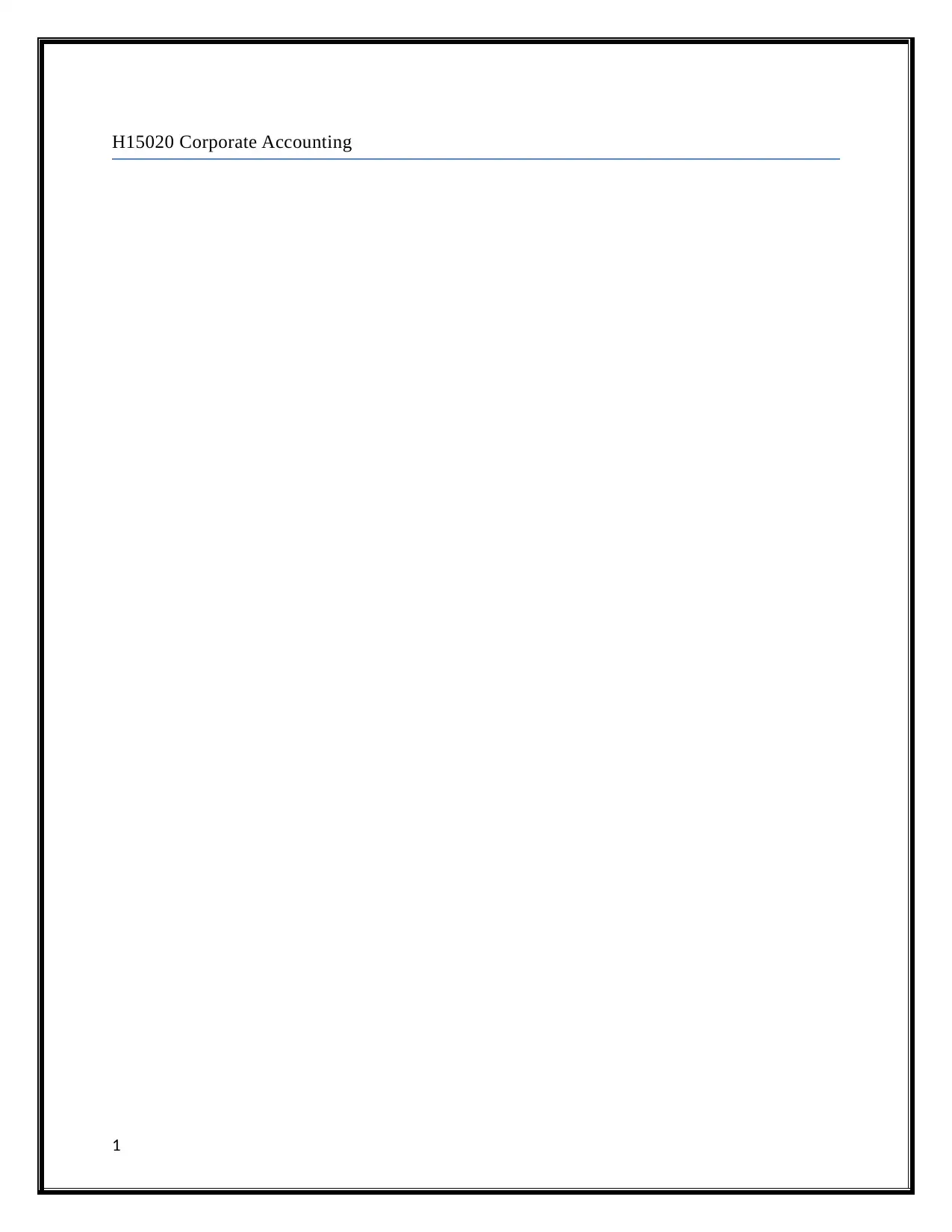
H15020 Corporate Accounting
1
1
Secure Best Marks with AI Grader
Need help grading? Try our AI Grader for instant feedback on your assignments.
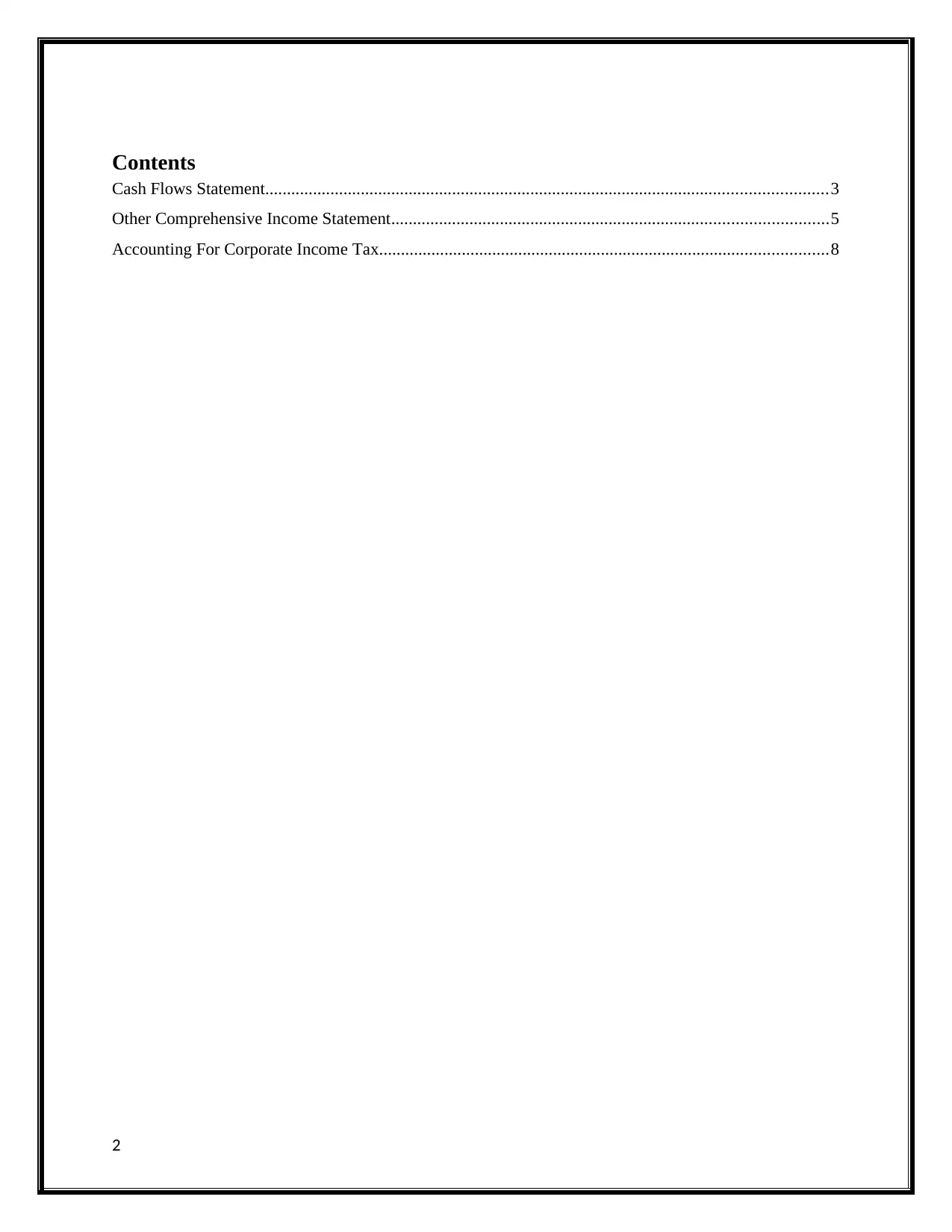
Contents
Cash Flows Statement.................................................................................................................................3
Other Comprehensive Income Statement....................................................................................................5
Accounting For Corporate Income Tax.......................................................................................................8
2
Cash Flows Statement.................................................................................................................................3
Other Comprehensive Income Statement....................................................................................................5
Accounting For Corporate Income Tax.......................................................................................................8
2
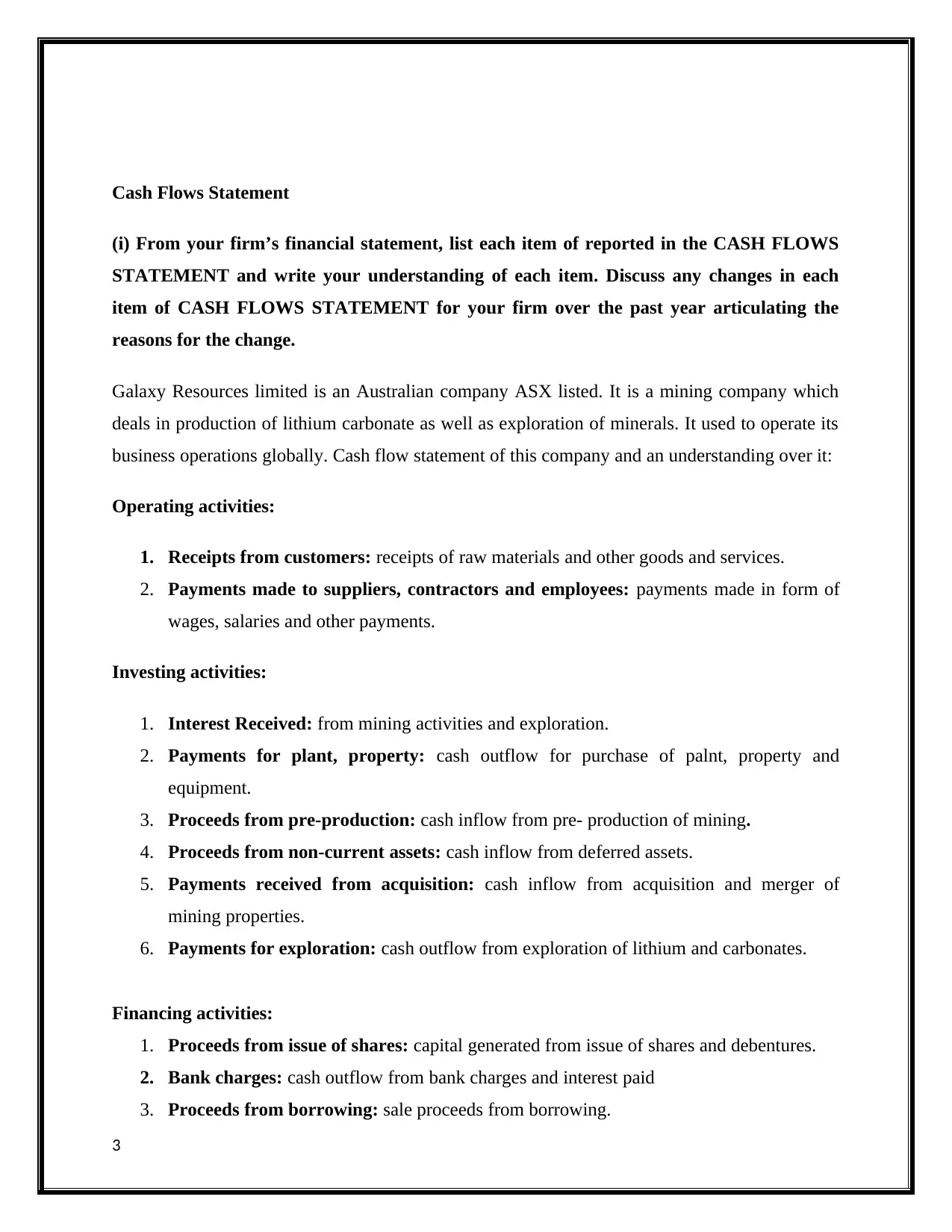
Cash Flows Statement
(i) From your firm’s financial statement, list each item of reported in the CASH FLOWS
STATEMENT and write your understanding of each item. Discuss any changes in each
item of CASH FLOWS STATEMENT for your firm over the past year articulating the
reasons for the change.
Galaxy Resources limited is an Australian company ASX listed. It is a mining company which
deals in production of lithium carbonate as well as exploration of minerals. It used to operate its
business operations globally. Cash flow statement of this company and an understanding over it:
Operating activities:
1. Receipts from customers: receipts of raw materials and other goods and services.
2. Payments made to suppliers, contractors and employees: payments made in form of
wages, salaries and other payments.
Investing activities:
1. Interest Received: from mining activities and exploration.
2. Payments for plant, property: cash outflow for purchase of palnt, property and
equipment.
3. Proceeds from pre-production: cash inflow from pre- production of mining.
4. Proceeds from non-current assets: cash inflow from deferred assets.
5. Payments received from acquisition: cash inflow from acquisition and merger of
mining properties.
6. Payments for exploration: cash outflow from exploration of lithium and carbonates.
Financing activities:
1. Proceeds from issue of shares: capital generated from issue of shares and debentures.
2. Bank charges: cash outflow from bank charges and interest paid
3. Proceeds from borrowing: sale proceeds from borrowing.
3
(i) From your firm’s financial statement, list each item of reported in the CASH FLOWS
STATEMENT and write your understanding of each item. Discuss any changes in each
item of CASH FLOWS STATEMENT for your firm over the past year articulating the
reasons for the change.
Galaxy Resources limited is an Australian company ASX listed. It is a mining company which
deals in production of lithium carbonate as well as exploration of minerals. It used to operate its
business operations globally. Cash flow statement of this company and an understanding over it:
Operating activities:
1. Receipts from customers: receipts of raw materials and other goods and services.
2. Payments made to suppliers, contractors and employees: payments made in form of
wages, salaries and other payments.
Investing activities:
1. Interest Received: from mining activities and exploration.
2. Payments for plant, property: cash outflow for purchase of palnt, property and
equipment.
3. Proceeds from pre-production: cash inflow from pre- production of mining.
4. Proceeds from non-current assets: cash inflow from deferred assets.
5. Payments received from acquisition: cash inflow from acquisition and merger of
mining properties.
6. Payments for exploration: cash outflow from exploration of lithium and carbonates.
Financing activities:
1. Proceeds from issue of shares: capital generated from issue of shares and debentures.
2. Bank charges: cash outflow from bank charges and interest paid
3. Proceeds from borrowing: sale proceeds from borrowing.
3

4. Transaction cost: book keeping of accounts and register cost.
5. Repayment of borrowing: outflow of cash paying amount with interest
ii) Provide a comparative analysis of your company’s three broad categories of cash flows
(operating activities, investing activities, financing activities) and make a comparative
evaluation for three years.
A brief comparative analysis of galaxy Resources from the three categories of cash flow
statement are given below as
Consolidated Statements of cash flows for the year 31st December 2015, 2016 and 2017
Activities 2015 2016 2017
Operating (7194) 2,621 57,087
Investing 45144 (15,063) (35,154)
Financing 49,766 17,079 29,806
Notes: () brackets show the negative balance of net cash flows and are depicted as cash outflow.
Whereas + shows the positive balance of net cash flows and are ducted as cash inflow.
Operating activities: it is the cash adjustments which rose from operations of the business. The
net cash flow from three years are explained above the difference in 2015-16 is 4573 and in 2016-
17 it is 54,466 both the figures denote the positive balance so there is cash inflow from receipts
from customers and other taxation office.
Investing activities: The difference in 2015-16 is (30,081) and 2016-17 is (20,091). As there is
cash outflow which means payments made for purchase of equipment, plant and property for
mining of lithium and carbonates.
4
5. Repayment of borrowing: outflow of cash paying amount with interest
ii) Provide a comparative analysis of your company’s three broad categories of cash flows
(operating activities, investing activities, financing activities) and make a comparative
evaluation for three years.
A brief comparative analysis of galaxy Resources from the three categories of cash flow
statement are given below as
Consolidated Statements of cash flows for the year 31st December 2015, 2016 and 2017
Activities 2015 2016 2017
Operating (7194) 2,621 57,087
Investing 45144 (15,063) (35,154)
Financing 49,766 17,079 29,806
Notes: () brackets show the negative balance of net cash flows and are depicted as cash outflow.
Whereas + shows the positive balance of net cash flows and are ducted as cash inflow.
Operating activities: it is the cash adjustments which rose from operations of the business. The
net cash flow from three years are explained above the difference in 2015-16 is 4573 and in 2016-
17 it is 54,466 both the figures denote the positive balance so there is cash inflow from receipts
from customers and other taxation office.
Investing activities: The difference in 2015-16 is (30,081) and 2016-17 is (20,091). As there is
cash outflow which means payments made for purchase of equipment, plant and property for
mining of lithium and carbonates.
4
Secure Best Marks with AI Grader
Need help grading? Try our AI Grader for instant feedback on your assignments.
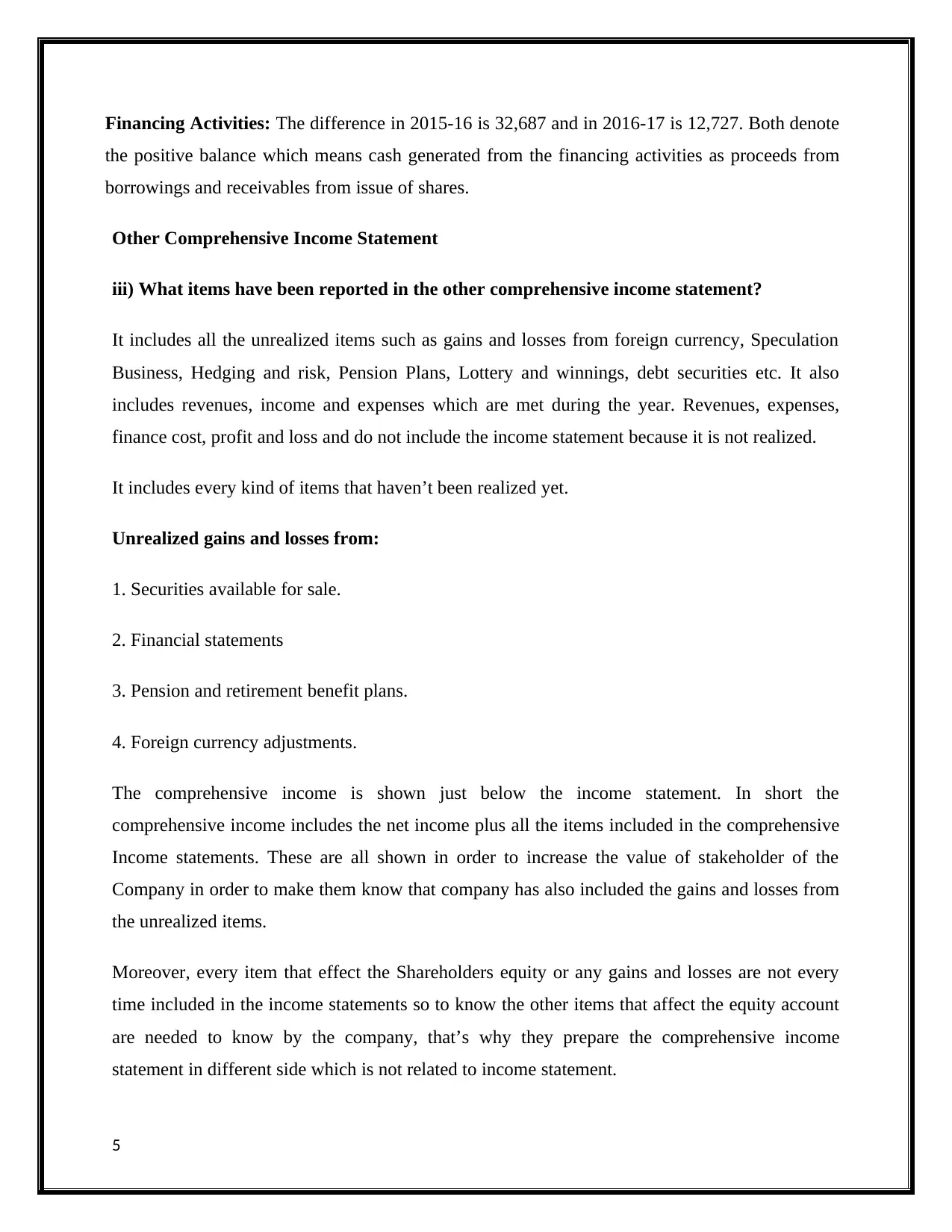
Financing Activities: The difference in 2015-16 is 32,687 and in 2016-17 is 12,727. Both denote
the positive balance which means cash generated from the financing activities as proceeds from
borrowings and receivables from issue of shares.
Other Comprehensive Income Statement
iii) What items have been reported in the other comprehensive income statement?
It includes all the unrealized items such as gains and losses from foreign currency, Speculation
Business, Hedging and risk, Pension Plans, Lottery and winnings, debt securities etc. It also
includes revenues, income and expenses which are met during the year. Revenues, expenses,
finance cost, profit and loss and do not include the income statement because it is not realized.
It includes every kind of items that haven’t been realized yet.
Unrealized gains and losses from:
1. Securities available for sale.
2. Financial statements
3. Pension and retirement benefit plans.
4. Foreign currency adjustments.
The comprehensive income is shown just below the income statement. In short the
comprehensive income includes the net income plus all the items included in the comprehensive
Income statements. These are all shown in order to increase the value of stakeholder of the
Company in order to make them know that company has also included the gains and losses from
the unrealized items.
Moreover, every item that effect the Shareholders equity or any gains and losses are not every
time included in the income statements so to know the other items that affect the equity account
are needed to know by the company, that’s why they prepare the comprehensive income
statement in different side which is not related to income statement.
5
the positive balance which means cash generated from the financing activities as proceeds from
borrowings and receivables from issue of shares.
Other Comprehensive Income Statement
iii) What items have been reported in the other comprehensive income statement?
It includes all the unrealized items such as gains and losses from foreign currency, Speculation
Business, Hedging and risk, Pension Plans, Lottery and winnings, debt securities etc. It also
includes revenues, income and expenses which are met during the year. Revenues, expenses,
finance cost, profit and loss and do not include the income statement because it is not realized.
It includes every kind of items that haven’t been realized yet.
Unrealized gains and losses from:
1. Securities available for sale.
2. Financial statements
3. Pension and retirement benefit plans.
4. Foreign currency adjustments.
The comprehensive income is shown just below the income statement. In short the
comprehensive income includes the net income plus all the items included in the comprehensive
Income statements. These are all shown in order to increase the value of stakeholder of the
Company in order to make them know that company has also included the gains and losses from
the unrealized items.
Moreover, every item that effect the Shareholders equity or any gains and losses are not every
time included in the income statements so to know the other items that affect the equity account
are needed to know by the company, that’s why they prepare the comprehensive income
statement in different side which is not related to income statement.
5
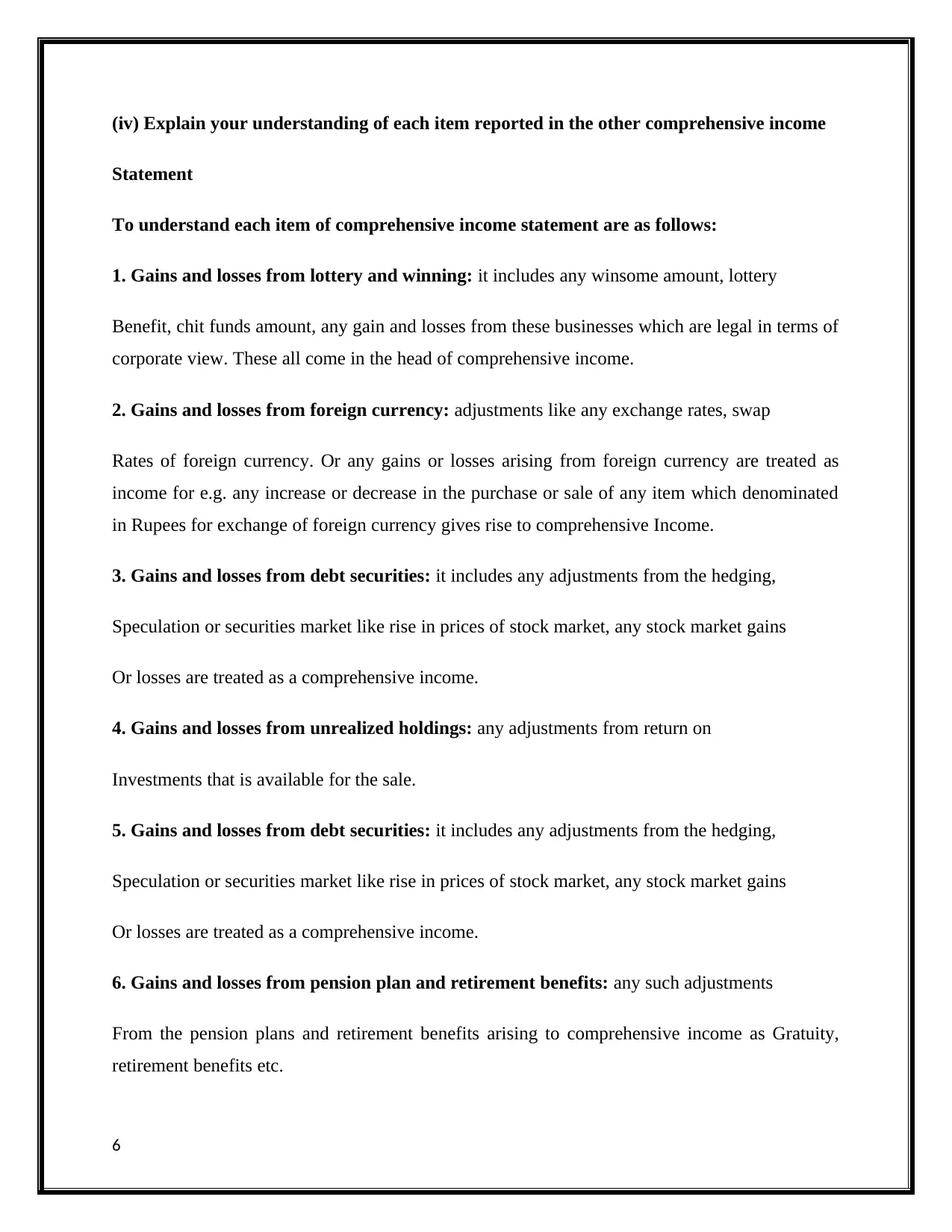
(iv) Explain your understanding of each item reported in the other comprehensive income
Statement
To understand each item of comprehensive income statement are as follows:
1. Gains and losses from lottery and winning: it includes any winsome amount, lottery
Benefit, chit funds amount, any gain and losses from these businesses which are legal in terms of
corporate view. These all come in the head of comprehensive income.
2. Gains and losses from foreign currency: adjustments like any exchange rates, swap
Rates of foreign currency. Or any gains or losses arising from foreign currency are treated as
income for e.g. any increase or decrease in the purchase or sale of any item which denominated
in Rupees for exchange of foreign currency gives rise to comprehensive Income.
3. Gains and losses from debt securities: it includes any adjustments from the hedging,
Speculation or securities market like rise in prices of stock market, any stock market gains
Or losses are treated as a comprehensive income.
4. Gains and losses from unrealized holdings: any adjustments from return on
Investments that is available for the sale.
5. Gains and losses from debt securities: it includes any adjustments from the hedging,
Speculation or securities market like rise in prices of stock market, any stock market gains
Or losses are treated as a comprehensive income.
6. Gains and losses from pension plan and retirement benefits: any such adjustments
From the pension plans and retirement benefits arising to comprehensive income as Gratuity,
retirement benefits etc.
6
Statement
To understand each item of comprehensive income statement are as follows:
1. Gains and losses from lottery and winning: it includes any winsome amount, lottery
Benefit, chit funds amount, any gain and losses from these businesses which are legal in terms of
corporate view. These all come in the head of comprehensive income.
2. Gains and losses from foreign currency: adjustments like any exchange rates, swap
Rates of foreign currency. Or any gains or losses arising from foreign currency are treated as
income for e.g. any increase or decrease in the purchase or sale of any item which denominated
in Rupees for exchange of foreign currency gives rise to comprehensive Income.
3. Gains and losses from debt securities: it includes any adjustments from the hedging,
Speculation or securities market like rise in prices of stock market, any stock market gains
Or losses are treated as a comprehensive income.
4. Gains and losses from unrealized holdings: any adjustments from return on
Investments that is available for the sale.
5. Gains and losses from debt securities: it includes any adjustments from the hedging,
Speculation or securities market like rise in prices of stock market, any stock market gains
Or losses are treated as a comprehensive income.
6. Gains and losses from pension plan and retirement benefits: any such adjustments
From the pension plans and retirement benefits arising to comprehensive income as Gratuity,
retirement benefits etc.
6

(v) Why these items have not been reported in Income Statement/Profit and Loss
Statement
The items of income statement include all the realized items. Income statement or profit and loss
statements are the financial statements which include all the expenses and income which are
directly related to company. On the other hand, comprehensive includes only unrealized income
such as gains and losses arising from speculation or hedging business, pension or retirement
plans, adjustment from foreign currency, gains or losses arising from the investment holding
available for sale.
These all items are not shown in Profit & loss statements because are not realized; they are
shown below the head of P&L because they should in different head so that even individual,
stakeholder or shareholder can know the equity they pose in the company. All the items shown
are that which increases or decreases the value of stakeholder that why they shown apart.
Moreover, the reason to show them apart is they are not a part of P&L. It will be more convents
to show it separately.
Accounting For Corporate Income Tax
(vi) What is your firm’s tax expense in its latest financial statements?
Tax expenses are the actual tax that is calculated by the company using a mathematical formula,
it usually depicted as expenses of company. It is also known as taxable income before tax. It is
truly different from tax payable.
The tax expense for the financial year 31st December 2017 is as follows:
It is $64,686 and (5,999) respectively in 2016 and 2017. The tax expense of any firm is shown in
the income statement.
The tax expense used to variant from year to year on the basis of different mathematical formula
applied in calculation of tax. Tax expense usually come or depicted in the income statement or
the profit and loss statement. They are the expense and are very different from tax payable.
7
Statement
The items of income statement include all the realized items. Income statement or profit and loss
statements are the financial statements which include all the expenses and income which are
directly related to company. On the other hand, comprehensive includes only unrealized income
such as gains and losses arising from speculation or hedging business, pension or retirement
plans, adjustment from foreign currency, gains or losses arising from the investment holding
available for sale.
These all items are not shown in Profit & loss statements because are not realized; they are
shown below the head of P&L because they should in different head so that even individual,
stakeholder or shareholder can know the equity they pose in the company. All the items shown
are that which increases or decreases the value of stakeholder that why they shown apart.
Moreover, the reason to show them apart is they are not a part of P&L. It will be more convents
to show it separately.
Accounting For Corporate Income Tax
(vi) What is your firm’s tax expense in its latest financial statements?
Tax expenses are the actual tax that is calculated by the company using a mathematical formula,
it usually depicted as expenses of company. It is also known as taxable income before tax. It is
truly different from tax payable.
The tax expense for the financial year 31st December 2017 is as follows:
It is $64,686 and (5,999) respectively in 2016 and 2017. The tax expense of any firm is shown in
the income statement.
The tax expense used to variant from year to year on the basis of different mathematical formula
applied in calculation of tax. Tax expense usually come or depicted in the income statement or
the profit and loss statement. They are the expense and are very different from tax payable.
7
Paraphrase This Document
Need a fresh take? Get an instant paraphrase of this document with our AI Paraphraser
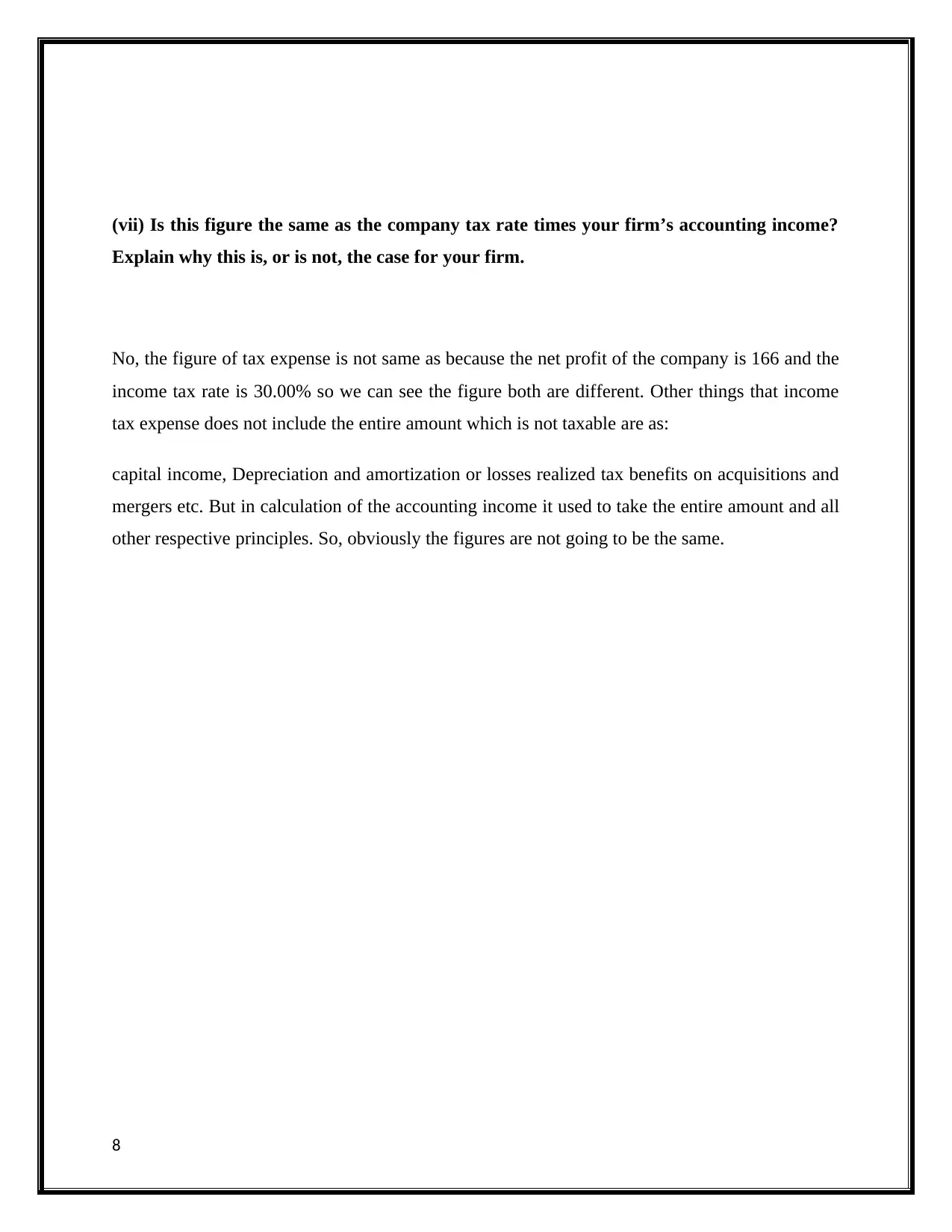
(vii) Is this figure the same as the company tax rate times your firm’s accounting income?
Explain why this is, or is not, the case for your firm.
No, the figure of tax expense is not same as because the net profit of the company is 166 and the
income tax rate is 30.00% so we can see the figure both are different. Other things that income
tax expense does not include the entire amount which is not taxable are as:
capital income, Depreciation and amortization or losses realized tax benefits on acquisitions and
mergers etc. But in calculation of the accounting income it used to take the entire amount and all
other respective principles. So, obviously the figures are not going to be the same.
8
Explain why this is, or is not, the case for your firm.
No, the figure of tax expense is not same as because the net profit of the company is 166 and the
income tax rate is 30.00% so we can see the figure both are different. Other things that income
tax expense does not include the entire amount which is not taxable are as:
capital income, Depreciation and amortization or losses realized tax benefits on acquisitions and
mergers etc. But in calculation of the accounting income it used to take the entire amount and all
other respective principles. So, obviously the figures are not going to be the same.
8
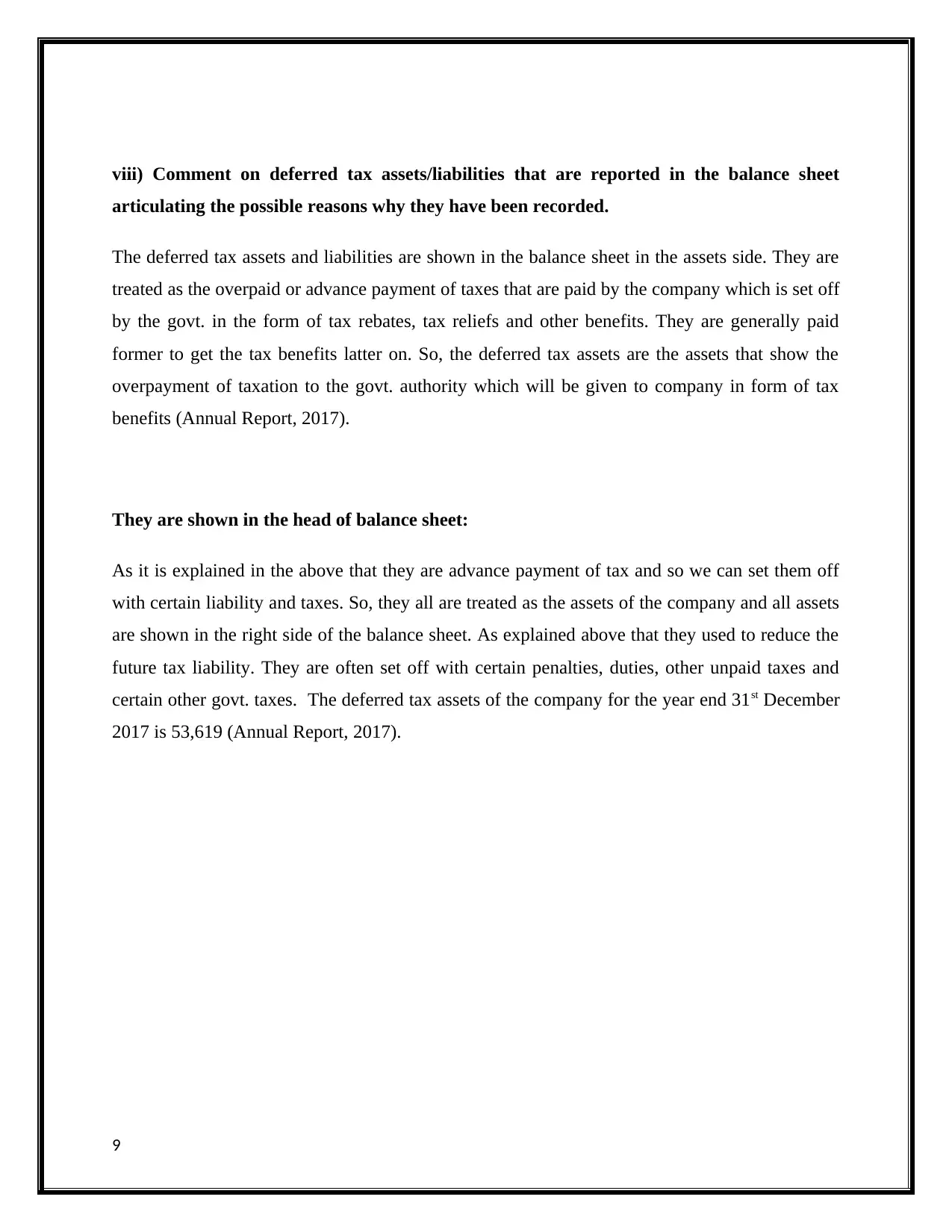
viii) Comment on deferred tax assets/liabilities that are reported in the balance sheet
articulating the possible reasons why they have been recorded.
The deferred tax assets and liabilities are shown in the balance sheet in the assets side. They are
treated as the overpaid or advance payment of taxes that are paid by the company which is set off
by the govt. in the form of tax rebates, tax reliefs and other benefits. They are generally paid
former to get the tax benefits latter on. So, the deferred tax assets are the assets that show the
overpayment of taxation to the govt. authority which will be given to company in form of tax
benefits (Annual Report, 2017).
They are shown in the head of balance sheet:
As it is explained in the above that they are advance payment of tax and so we can set them off
with certain liability and taxes. So, they all are treated as the assets of the company and all assets
are shown in the right side of the balance sheet. As explained above that they used to reduce the
future tax liability. They are often set off with certain penalties, duties, other unpaid taxes and
certain other govt. taxes. The deferred tax assets of the company for the year end 31st December
2017 is 53,619 (Annual Report, 2017).
9
articulating the possible reasons why they have been recorded.
The deferred tax assets and liabilities are shown in the balance sheet in the assets side. They are
treated as the overpaid or advance payment of taxes that are paid by the company which is set off
by the govt. in the form of tax rebates, tax reliefs and other benefits. They are generally paid
former to get the tax benefits latter on. So, the deferred tax assets are the assets that show the
overpayment of taxation to the govt. authority which will be given to company in form of tax
benefits (Annual Report, 2017).
They are shown in the head of balance sheet:
As it is explained in the above that they are advance payment of tax and so we can set them off
with certain liability and taxes. So, they all are treated as the assets of the company and all assets
are shown in the right side of the balance sheet. As explained above that they used to reduce the
future tax liability. They are often set off with certain penalties, duties, other unpaid taxes and
certain other govt. taxes. The deferred tax assets of the company for the year end 31st December
2017 is 53,619 (Annual Report, 2017).
9
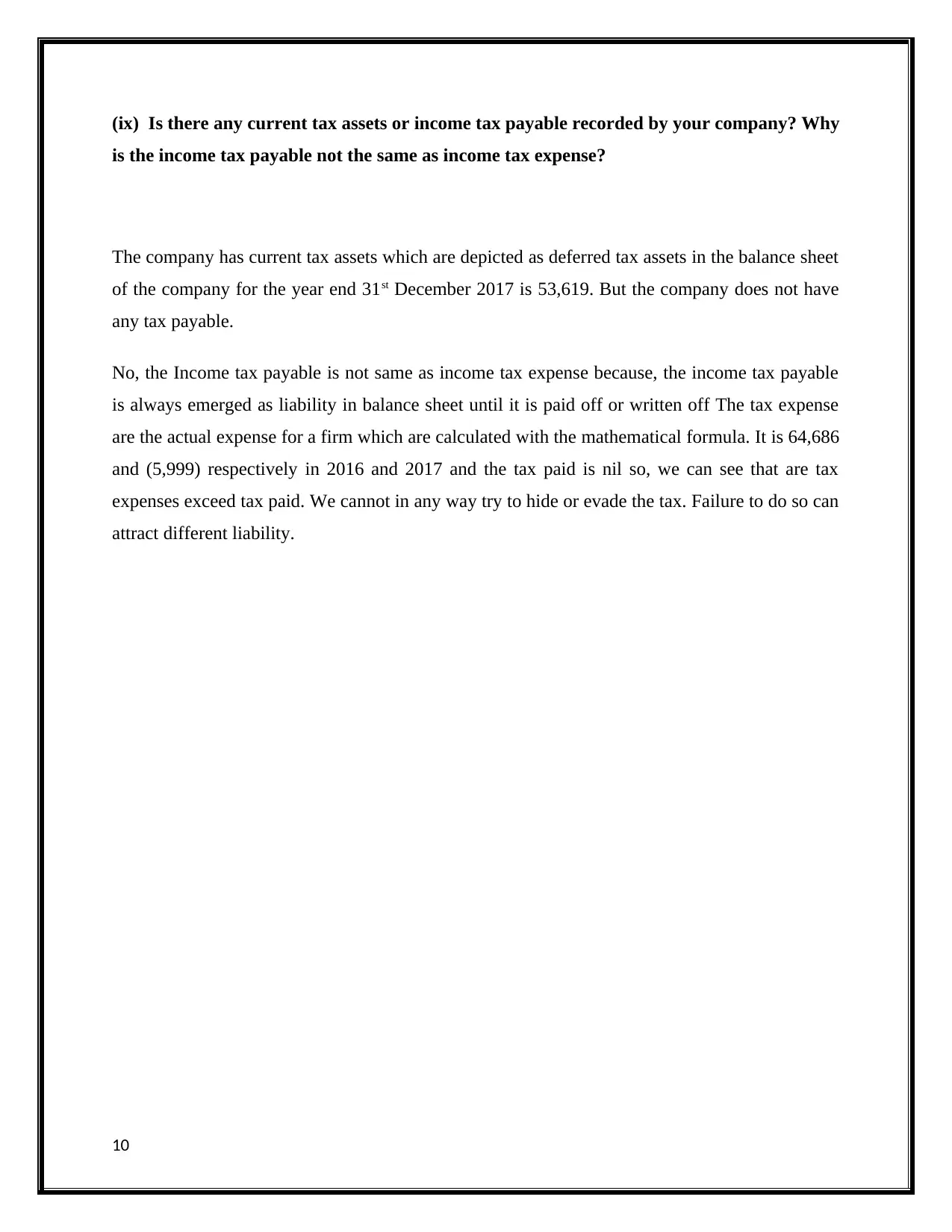
(ix) Is there any current tax assets or income tax payable recorded by your company? Why
is the income tax payable not the same as income tax expense?
The company has current tax assets which are depicted as deferred tax assets in the balance sheet
of the company for the year end 31st December 2017 is 53,619. But the company does not have
any tax payable.
No, the Income tax payable is not same as income tax expense because, the income tax payable
is always emerged as liability in balance sheet until it is paid off or written off The tax expense
are the actual expense for a firm which are calculated with the mathematical formula. It is 64,686
and (5,999) respectively in 2016 and 2017 and the tax paid is nil so, we can see that are tax
expenses exceed tax paid. We cannot in any way try to hide or evade the tax. Failure to do so can
attract different liability.
10
is the income tax payable not the same as income tax expense?
The company has current tax assets which are depicted as deferred tax assets in the balance sheet
of the company for the year end 31st December 2017 is 53,619. But the company does not have
any tax payable.
No, the Income tax payable is not same as income tax expense because, the income tax payable
is always emerged as liability in balance sheet until it is paid off or written off The tax expense
are the actual expense for a firm which are calculated with the mathematical formula. It is 64,686
and (5,999) respectively in 2016 and 2017 and the tax paid is nil so, we can see that are tax
expenses exceed tax paid. We cannot in any way try to hide or evade the tax. Failure to do so can
attract different liability.
10
Secure Best Marks with AI Grader
Need help grading? Try our AI Grader for instant feedback on your assignments.
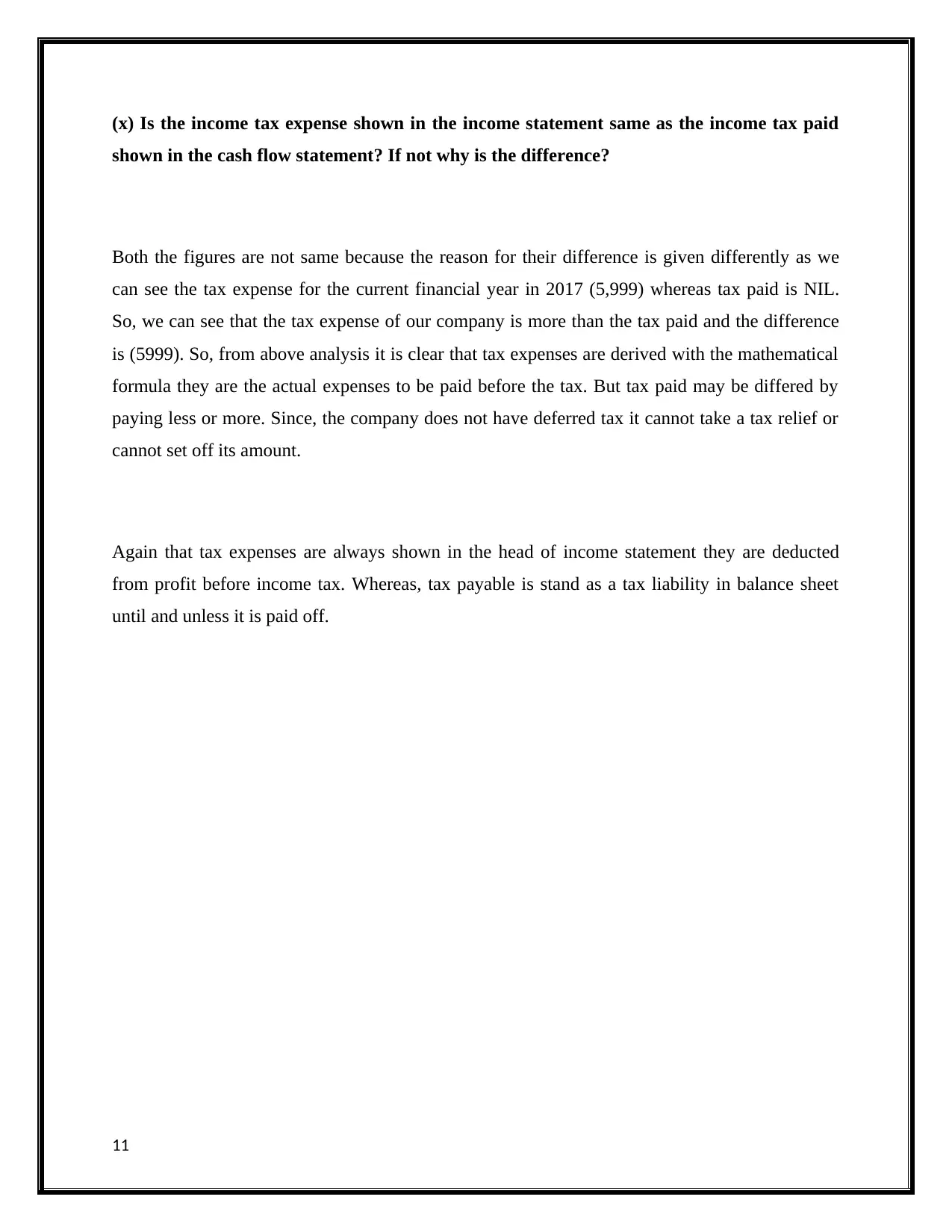
(x) Is the income tax expense shown in the income statement same as the income tax paid
shown in the cash flow statement? If not why is the difference?
Both the figures are not same because the reason for their difference is given differently as we
can see the tax expense for the current financial year in 2017 (5,999) whereas tax paid is NIL.
So, we can see that the tax expense of our company is more than the tax paid and the difference
is (5999). So, from above analysis it is clear that tax expenses are derived with the mathematical
formula they are the actual expenses to be paid before the tax. But tax paid may be differed by
paying less or more. Since, the company does not have deferred tax it cannot take a tax relief or
cannot set off its amount.
Again that tax expenses are always shown in the head of income statement they are deducted
from profit before income tax. Whereas, tax payable is stand as a tax liability in balance sheet
until and unless it is paid off.
11
shown in the cash flow statement? If not why is the difference?
Both the figures are not same because the reason for their difference is given differently as we
can see the tax expense for the current financial year in 2017 (5,999) whereas tax paid is NIL.
So, we can see that the tax expense of our company is more than the tax paid and the difference
is (5999). So, from above analysis it is clear that tax expenses are derived with the mathematical
formula they are the actual expenses to be paid before the tax. But tax paid may be differed by
paying less or more. Since, the company does not have deferred tax it cannot take a tax relief or
cannot set off its amount.
Again that tax expenses are always shown in the head of income statement they are deducted
from profit before income tax. Whereas, tax payable is stand as a tax liability in balance sheet
until and unless it is paid off.
11
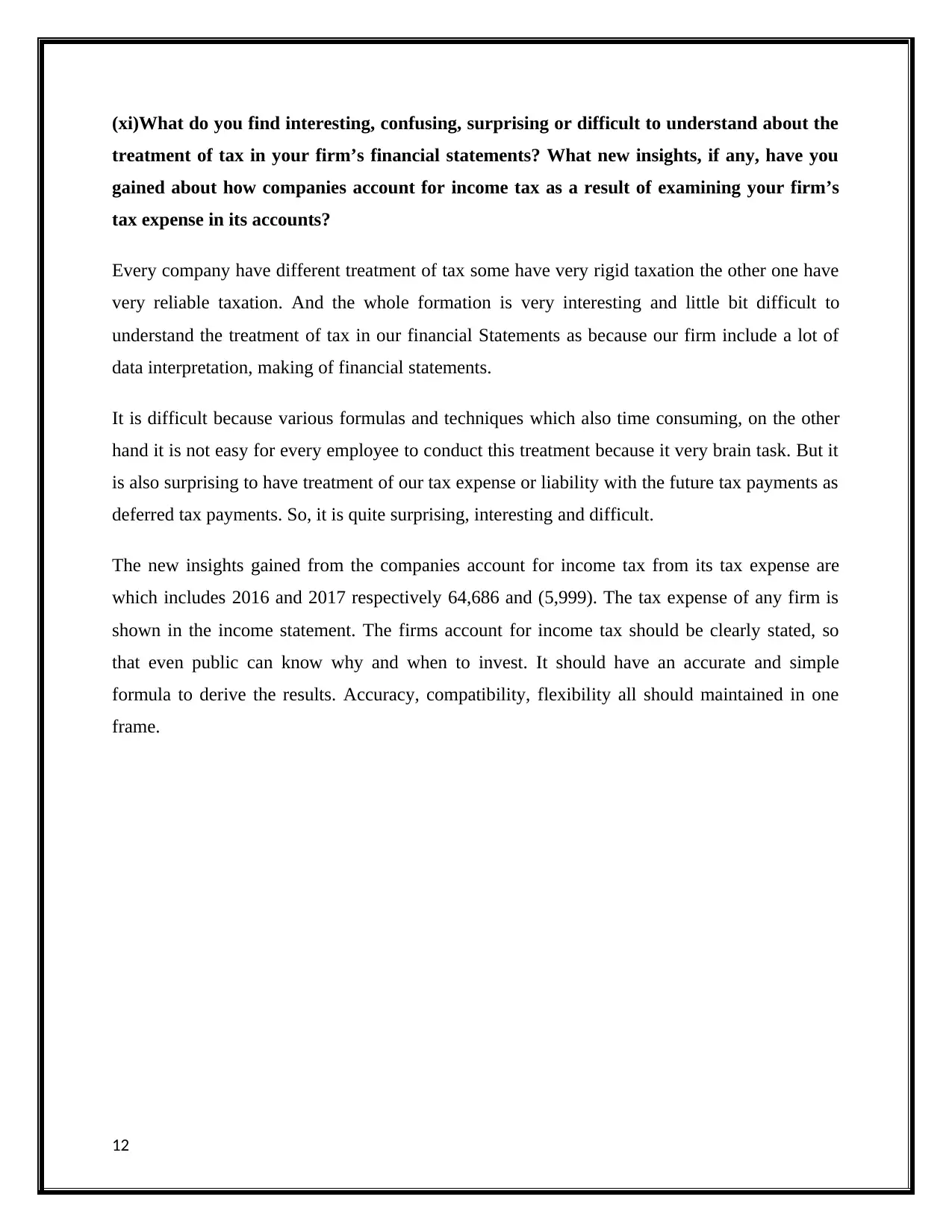
(xi)What do you find interesting, confusing, surprising or difficult to understand about the
treatment of tax in your firm’s financial statements? What new insights, if any, have you
gained about how companies account for income tax as a result of examining your firm’s
tax expense in its accounts?
Every company have different treatment of tax some have very rigid taxation the other one have
very reliable taxation. And the whole formation is very interesting and little bit difficult to
understand the treatment of tax in our financial Statements as because our firm include a lot of
data interpretation, making of financial statements.
It is difficult because various formulas and techniques which also time consuming, on the other
hand it is not easy for every employee to conduct this treatment because it very brain task. But it
is also surprising to have treatment of our tax expense or liability with the future tax payments as
deferred tax payments. So, it is quite surprising, interesting and difficult.
The new insights gained from the companies account for income tax from its tax expense are
which includes 2016 and 2017 respectively 64,686 and (5,999). The tax expense of any firm is
shown in the income statement. The firms account for income tax should be clearly stated, so
that even public can know why and when to invest. It should have an accurate and simple
formula to derive the results. Accuracy, compatibility, flexibility all should maintained in one
frame.
12
treatment of tax in your firm’s financial statements? What new insights, if any, have you
gained about how companies account for income tax as a result of examining your firm’s
tax expense in its accounts?
Every company have different treatment of tax some have very rigid taxation the other one have
very reliable taxation. And the whole formation is very interesting and little bit difficult to
understand the treatment of tax in our financial Statements as because our firm include a lot of
data interpretation, making of financial statements.
It is difficult because various formulas and techniques which also time consuming, on the other
hand it is not easy for every employee to conduct this treatment because it very brain task. But it
is also surprising to have treatment of our tax expense or liability with the future tax payments as
deferred tax payments. So, it is quite surprising, interesting and difficult.
The new insights gained from the companies account for income tax from its tax expense are
which includes 2016 and 2017 respectively 64,686 and (5,999). The tax expense of any firm is
shown in the income statement. The firms account for income tax should be clearly stated, so
that even public can know why and when to invest. It should have an accurate and simple
formula to derive the results. Accuracy, compatibility, flexibility all should maintained in one
frame.
12
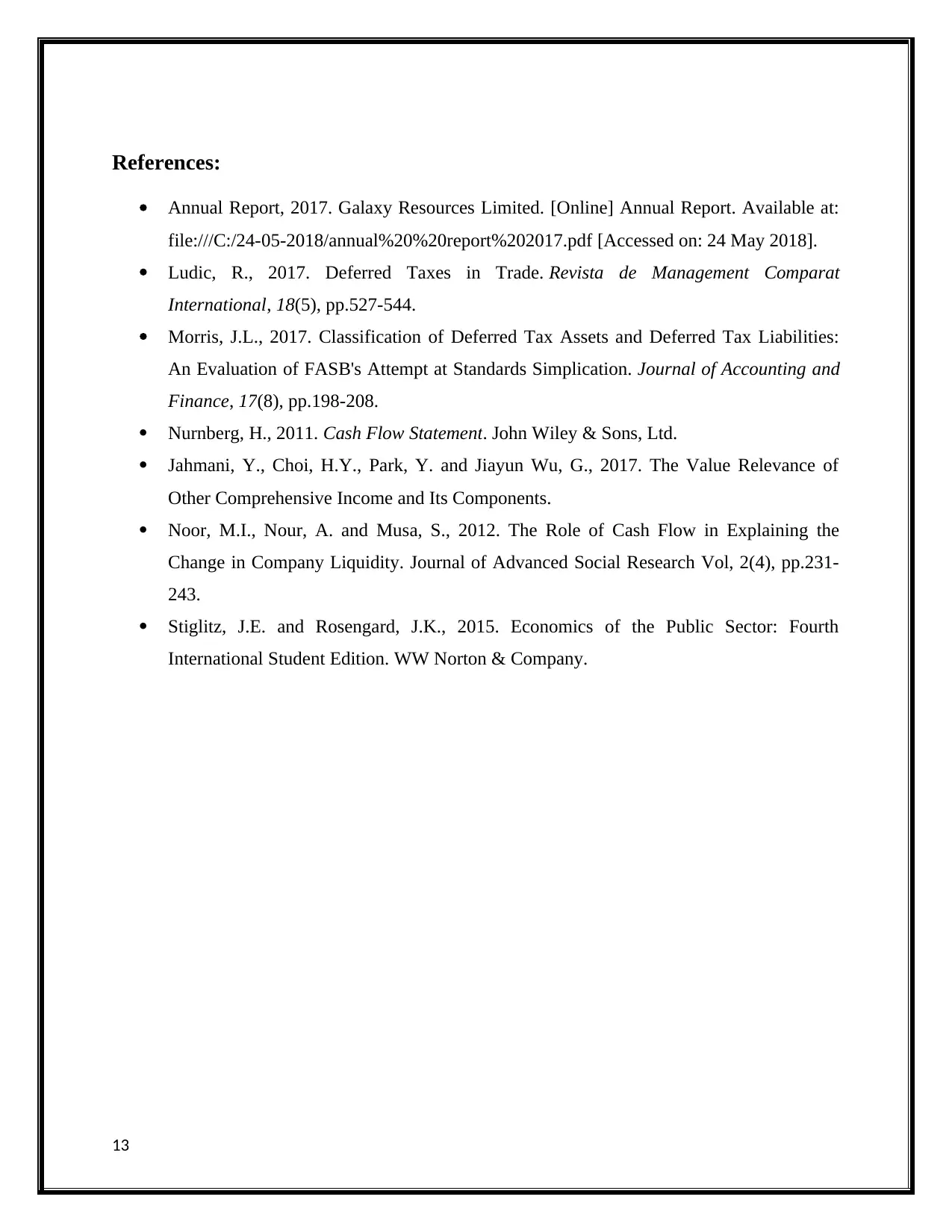
References:
Annual Report, 2017. Galaxy Resources Limited. [Online] Annual Report. Available at:
file:///C:/24-05-2018/annual%20%20report%202017.pdf [Accessed on: 24 May 2018].
Ludic, R., 2017. Deferred Taxes in Trade. Revista de Management Comparat
International, 18(5), pp.527-544.
Morris, J.L., 2017. Classification of Deferred Tax Assets and Deferred Tax Liabilities:
An Evaluation of FASB's Attempt at Standards Simplication. Journal of Accounting and
Finance, 17(8), pp.198-208.
Nurnberg, H., 2011. Cash Flow Statement. John Wiley & Sons, Ltd.
Jahmani, Y., Choi, H.Y., Park, Y. and Jiayun Wu, G., 2017. The Value Relevance of
Other Comprehensive Income and Its Components.
Noor, M.I., Nour, A. and Musa, S., 2012. The Role of Cash Flow in Explaining the
Change in Company Liquidity. Journal of Advanced Social Research Vol, 2(4), pp.231-
243.
Stiglitz, J.E. and Rosengard, J.K., 2015. Economics of the Public Sector: Fourth
International Student Edition. WW Norton & Company.
13
Annual Report, 2017. Galaxy Resources Limited. [Online] Annual Report. Available at:
file:///C:/24-05-2018/annual%20%20report%202017.pdf [Accessed on: 24 May 2018].
Ludic, R., 2017. Deferred Taxes in Trade. Revista de Management Comparat
International, 18(5), pp.527-544.
Morris, J.L., 2017. Classification of Deferred Tax Assets and Deferred Tax Liabilities:
An Evaluation of FASB's Attempt at Standards Simplication. Journal of Accounting and
Finance, 17(8), pp.198-208.
Nurnberg, H., 2011. Cash Flow Statement. John Wiley & Sons, Ltd.
Jahmani, Y., Choi, H.Y., Park, Y. and Jiayun Wu, G., 2017. The Value Relevance of
Other Comprehensive Income and Its Components.
Noor, M.I., Nour, A. and Musa, S., 2012. The Role of Cash Flow in Explaining the
Change in Company Liquidity. Journal of Advanced Social Research Vol, 2(4), pp.231-
243.
Stiglitz, J.E. and Rosengard, J.K., 2015. Economics of the Public Sector: Fourth
International Student Edition. WW Norton & Company.
13
1 out of 13
Your All-in-One AI-Powered Toolkit for Academic Success.
+13062052269
info@desklib.com
Available 24*7 on WhatsApp / Email
![[object Object]](/_next/static/media/star-bottom.7253800d.svg)
Unlock your academic potential
© 2024 | Zucol Services PVT LTD | All rights reserved.




